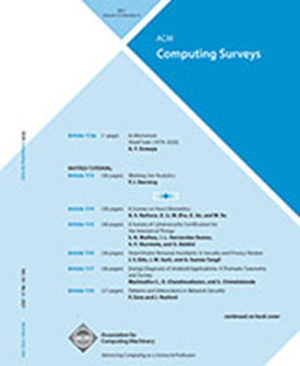视觉内容隐私保护:一项调查
IF 23.8
1区 计算机科学
Q1 COMPUTER SCIENCE, THEORY & METHODS
引用次数: 0
摘要
视觉是人们最重要的感官,也是人们认知的主要方式之一。因此,人们倾向于利用视觉内容来捕捉和分享自己的生活体验,这极大地方便了信息的传递。同时,这也增加了侵犯隐私的风险,例如,图像或视频可能会泄露各种隐私敏感信息。学者们一直坚持不懈地追求有针对性的隐私保护措施。各种调查试图从特定角度整合这些努力。然而,这些调查往往侧重于特定的问题、场景或技术,阻碍了在更大范围内对现有解决方案的全面概述。在本调查中,我们提出了一个包含视觉隐私的各种问题和解决方案的框架,以便从综合层面宏观了解隐私问题。它基于隐私问题都有相应的对手这一事实,将隐私保护分为三类:基于计算机视觉(CV)的对手、基于人类视觉(HV)的对手和基于 CV & HV 的对手。针对每个类别,我们分析了隐私保护主要方法的特点,然后系统回顾了具有代表性的解决方案。我们还讨论了视觉隐私保护面临的挑战和未来发展方向。本文章由计算机程序翻译,如有差异,请以英文原文为准。
Visual Content Privacy Protection: A Survey
Vision is the most important sense for people, and it is also one of the main ways of cognition. As a result, people tend to utilize visual content to capture and share their life experiences, which greatly facilitates the transfer of information. Meanwhile, it also increases the risk of privacy violations, e.g., an image or video can reveal different kinds of privacy-sensitive information. Scholars have persistently pursued the advancement of tailored privacy protection measures. Various surveys attempt to consolidate these efforts from specific viewpoints. Nevertheless, these surveys tend to focus on particular issues, scenarios, or technologies, hindering a comprehensive overview of existing solutions on a broader scale. In this survey, a framework that encompasses various concerns and solutions for visual privacy is proposed, which allows for a macro understanding of privacy concerns from a comprehensive level. It is based on the fact that privacy concerns have corresponding adversaries, and divides privacy protection into three categories, based on computer vision (CV) adversary, based on human vision (HV) adversary, and based on CV & HV adversary. For each category, we analyze the characteristics of the main approaches to privacy protection, and then systematically review representative solutions. Open challenges and future directions for visual privacy protection are also discussed.
求助全文
通过发布文献求助,成功后即可免费获取论文全文。
去求助
来源期刊

ACM Computing Surveys
工程技术-计算机:理论方法
CiteScore
33.20
自引率
0.60%
发文量
372
审稿时长
12 months
期刊介绍:
ACM Computing Surveys is an academic journal that focuses on publishing surveys and tutorials on various areas of computing research and practice. The journal aims to provide comprehensive and easily understandable articles that guide readers through the literature and help them understand topics outside their specialties. In terms of impact, CSUR has a high reputation with a 2022 Impact Factor of 16.6. It is ranked 3rd out of 111 journals in the field of Computer Science Theory & Methods.
ACM Computing Surveys is indexed and abstracted in various services, including AI2 Semantic Scholar, Baidu, Clarivate/ISI: JCR, CNKI, DeepDyve, DTU, EBSCO: EDS/HOST, and IET Inspec, among others.
 求助内容:
求助内容: 应助结果提醒方式:
应助结果提醒方式:


